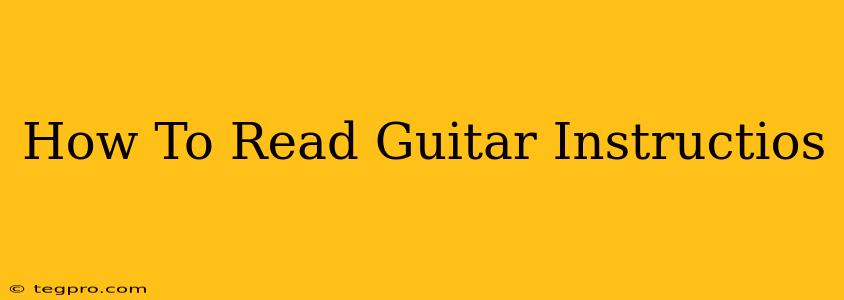Learning guitar is an exciting journey, but understanding how to read guitar instructions is the first crucial step. This guide will help you decipher both tablature (tab) and standard musical notation, empowering you to tackle any song or tutorial.
Understanding Guitar Tablature (Tab)
Tablature, or "tab," is a simplified way to represent guitar music. It shows you which strings to fret and when to pluck or strum them. Each line represents a guitar string, typically from thickest (low E) to thinnest (high E).
Decoding Tab:
- Lines: Each horizontal line represents a string on your guitar. The top line is typically the thickest (low E) string, and the bottom line is the thinnest (high E) string.
- Numbers: The numbers on each line indicate the fret number you should press down on that string. A "0" means you play the open string (no fret pressed).
- Timing: Tab doesn't explicitly show rhythm. You'll often need to listen to the song or refer to a rhythm guide to understand the timing of each note.
- Example: Let's say you see "0-2-3" on the top three lines of a tab. This means you play the open low E string, then the second fret on the A string, followed by the third fret on the D string.
Advantages of using Tab:
- Easy to learn: Relatively simple to understand, even for beginners.
- Quick to read: Provides a visual representation of finger placement.
- Widely available: Abundant tab for virtually every song imaginable online.
Disadvantages of using Tab:
- Limited musical information: Doesn't show rhythm, dynamics, or other musical nuances.
- Inconsistent formatting: Different websites and resources might use slightly different tab conventions.
- Can hinder musical understanding: Over-reliance on tab can limit your understanding of music theory.
Mastering Standard Musical Notation
Standard musical notation, while more complex than tab, offers a much richer understanding of the music. It provides information about rhythm, tempo, dynamics, and other musical details.
Essential Elements of Standard Notation for Guitar:
- Treble Clef: Indicates the pitch range of the notes.
- Notes: Represent the pitch and duration of a sound.
- Stave (Staff): Five horizontal lines on which the notes are placed.
- Time Signature: Indicates the number of beats per measure and the type of note representing one beat.
- Key Signature: Shows which sharps or flats are used throughout the piece.
- Rhythm: Displayed through note values (whole, half, quarter, etc.).
Advantages of using Standard Notation:
- Complete musical information: Provides a comprehensive representation of the music.
- Develops musical understanding: Learning to read standard notation enhances your understanding of music theory.
- Professional standard: Essential for serious musicians and composers.
Disadvantages of using Standard Notation:
- Steeper learning curve: Requires more time and effort to learn.
- More complex to read: Takes longer to decipher than tab.
- Less readily available: Finding standard notation for every song might be challenging.
Bridging the Gap: Combining Tab and Standard Notation
The ideal approach is to learn both tab and standard notation. Start with tab to learn basic chords and songs quickly, then gradually transition to standard notation to deepen your musical knowledge. Many guitar methods books incorporate both systems, providing a well-rounded learning experience.
Practice Makes Perfect
Regardless of whether you use tab or standard notation, consistent practice is key. Regular playing builds muscle memory, improves coordination, and enhances your understanding of the instrument. Start with simple exercises and gradually increase the complexity as your skills develop. Remember to be patient and persistent; mastering guitar takes time and dedication.

